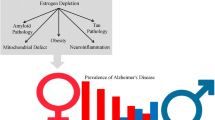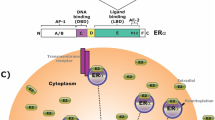Abstract
In the present study, to determine whether aging could increase the vulnerability of the brain to estrogen withdrawal-induced mitochondrial dysfunction, we measured the cytochrome c oxidase (COX) activity and mitochondrial adenosine triphosphate (ATP) content in hippocampi of 2 groups of ovariectomized (OVX) Wistar rats aged 2 months (young) and 9 months (middle-aged), respectively. In addition, effects of genistein and estradiol benzoate (EB) were tested also. We observed only a transient alteration of COX activity and mitochondrial ATP content in hippocampi of young OVX rats but a prolonged lowering of COX activity and mitochondrial ATP content in hippocampi of middle-aged OVX rats. This suggested that with aging compensatory mechanisms of mitochondrial function were attenuated, thus exacerbated estrogen withdrawal-induced mitochondrial dysfunction in hippocampi. Significantly, EB/genistein treatment reversed this estrogen withdrawal-induced mitochondrial dysfunction in both young and middle-aged rats suggesting that genistein may be used as a substitute for estradiol to prevent age-related disease such as Alzheimer’s disease in post-menopausal females.
Similar content being viewed by others
References
Abelenda M, Puerta M (1999) Eur J Endocrinol 141:630–636
Arendt J, Laud CA, Symons AM, Pryde SJ (1983) J Reprod Fertil 68(1):213–218
Assimacopoulos-Jeannet F, McCormack JG, Jeanrenaud B (1986) J Biol Chem 261:8799–8804
Aksenov MY, Tucker HM, Nair P, Aksenova MV, Butterfield DA, Estus S, Markesbery WR (1999) Neurochem Res 24:767–774
Beauvoit B, Rigoulet M (2001) IUBMB Life 52:143–152
Borras C, Sastre J, Garcia-Sala D, Lloret A, Pallardo FV, Vina J (2003) Free Radic Biol Med 34:546–552
Borras C, Gambini J, Vina J (2007) Front Biosci 12:1008–1013
Brand MD, D’Alessandri L, Reis HM, Hafner RP (1990) Arch Biochem Biophys 283:278–284
Drew B, Leeuwenburgh C (2003) Am J Physiol Regul Integr Comp Physiol 285:R1259–R1267
Garcia de La Asunción J, Millan A, Pla R, Bruseghini L, Esteras A, Pallardó FV, Sastre J, Viña J (1996) FASEB J 10:333–338
Heinrich R, Rapoport TA (1974) Eur J Biochem 42:89–95
Ho KP, Li L, Zhao L, Qian ZM (2003) Mol Cell Biochem 247:219–222
Korzeniewski B (2001) Biochim Biophys Acta 1504:31–45
Kacser H, Burns JA (1973) In rate control of biological processes: The control of flux. Cambridge University Press, Cambridge, pp 65–104
Kadenbach B, Huttemann M, Arnold S, Lee I, Bender E (2000) Free Radical Biol Med 29:211–221
Liu Z, Stafstrom CE, Sarkisian M, Tandon P, Yang Y, Hori A, Holmes GL (1996) Brain Res Dev Brain Res 97:178–184
Lecanu L, Yao W, Piechot A, Greeson J, Tzalis D, Papadopoulos V (2005) Neuropharmacology 49:86–96
Marks JD, Bindokas VP, Zhang XM (2000) Brain Res Dev Brain Res 124:101–116
Miquel J, Economos AC, Fleming J, Johnson JE, Jr (1980) Exp Gerontol 15:575–591
Miquel J, Ramirez-Bosca A, Ramirez-Bosca JV, Alperi JD (2006) Arch Gerontol Geriatr 42:289–306
Nilsen J, Brinton RD (2004) Curr Drug Targets CNS Neurol Disord 3:297–313
Reder C (1988) J Theor Biol 135:175–201
Rossignol R, Faustin B, Rocher C, Malgat M, Mazat JP, Letellier T (2003) Biochem J 370:751–762
Sastre J, Pallardó FV, Plá R, Pellín A, Juan G, O’Connor E, Estrela JM, Miquel J, Viña J (1996) Hepatology 24:1199–1205
Shi C, Xu XW, Forster EL, Tang LF, Ge Z, Yew DT (2008) Cell Biochem Funct 26:172–178
Toescu EC (2005) Philos Trans R Soc Lond B Biol Sci 360:2347–2354
Taivassalo T, Abbott A, Wyrick P, Haller RG (2002) Ann Neurol 51:38–44
Viña J, Borrás C, Gambini J, Sastre J, Pallardó FV (2005) Sci Aging Knowledge Environ 23:pe17
Ventura B, Genova M, Bovina C, Formiggini G, Lenaz G (2002) Biochim Biophys Acta 1553:249–260
Xu J, Zhu J, Shi C, Guo K, Yew DT (2007) J Mol Neurosci 31:101–112
Xu XW, Shi C, He ZQ, Ma CM, Chen WH, Shen YP, Guo Q, Shen CJ, Xu J (2008) Cell Mol Neurobiol [Epub ahead of print]
Author information
Authors and Affiliations
Corresponding author
Rights and permissions
About this article
Cite this article
Shi, C., Xu, J. Increased vulnerability of brain to estrogen withdrawal-induced mitochondrial dysfunction with aging. J Bioenerg Biomembr 40, 625–630 (2008). https://doi.org/10.1007/s10863-008-9195-1
Received:
Accepted:
Published:
Issue Date:
DOI: https://doi.org/10.1007/s10863-008-9195-1




